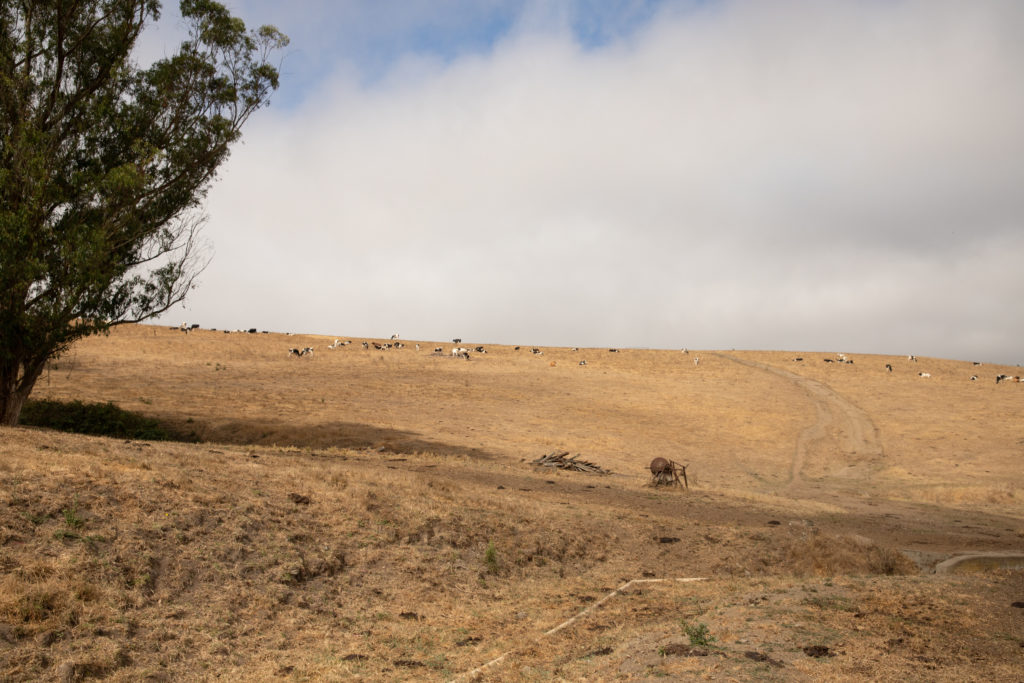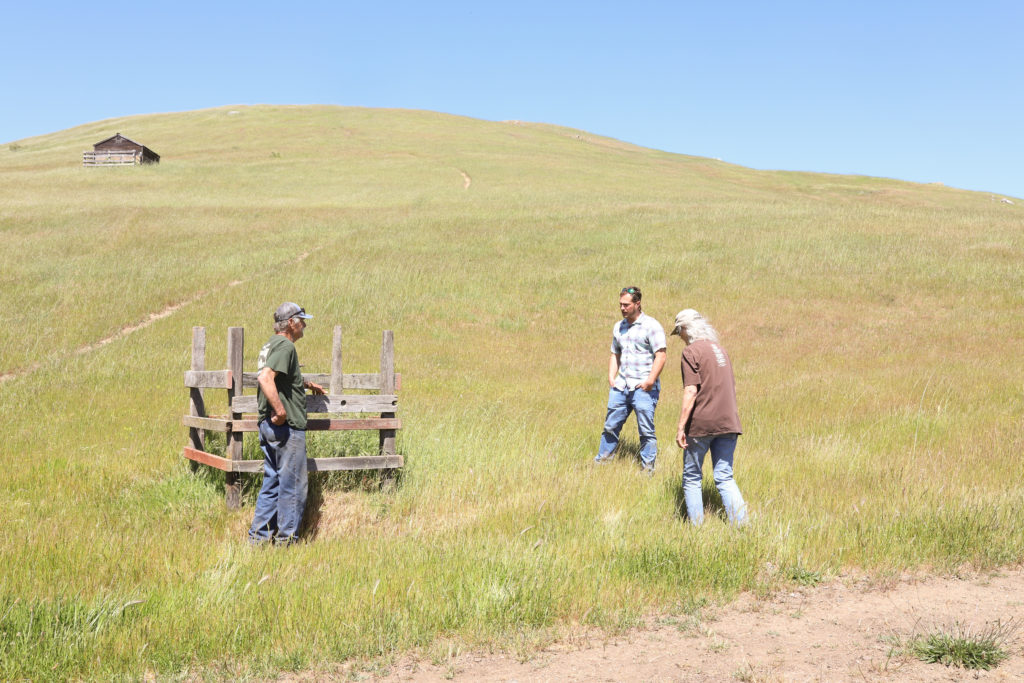Profiles on Building Drought Resilience
August 13, 2021

Lately I’ve spent a lot of time out on the land — driving by brown hillsides, talking to farmers and ranchers about the drought challenges they continue to face and learning more about the sacrifices they have had to make to keep their operations running.
What I continuously learn from these conversations is that Marin farmers and ranchers are innovative and resilient. I already know this, and I’m reminded of it over and over again — through fire seasons, through the pandemic and currently through the worst drought in the last 50 years.
As you may know, MALT, in partnership with local agencies and organizations, quickly responded to the drought by launching an emergency Drought Resilience & Water Security (DRAWS) initiative in April. To date, MALT has allocated $500,000 to DRAWS — an increase from our initial $250,000 — to help Marin County agriculturalists invest in drought-resilient practices and build long-term water security. Currently, there are 33 active DRAWS projects and roughly 10 potential projects in the pipeline, with more inquiries every week!
As Marin farmers and ranchers implement a broad range of DRAWS projects, I want to tell you more about two projects that demonstrate how crucial this work is to our local community. Thanks to our generous supporters and dedicated partners, we are taking collective action and making an impact.
 Dry Marin County pastures in early August.
Dry Marin County pastures in early August.Chileno Valley Ranch
I’ve talked to many farmers and ranchers over the past four months and many are saying that this is the worst drought they’ve seen in 50–70 years. Many ranchers are preparing for an excruciatingly long, dry season, and are looking for more water storage capacity to build off of existing water systems. Water storage is crucial for all types of agricultural projects including one we worked on with Chileno Valley Ranch.
Chileno Valley Ranch, MALT-protected since 2000, is owned and operated by Sally and Mike Gale who produce grass-fed lamb and beef along with u-pick apples in the fall. Sally and Mike have been farming and ranching for a couple of decades on 583 acres with reliable and plentiful water sources. But this year, the ponds are dry and the springs haven’t run.
According to Mike, this year Chileno Valley has had nine inches of rain. For perspective, the ranch had 12 inches in 2020 and 40 inches in 2019, with an average annual rainfall of 24 inches. “It’s been and continues to be a long summer. That’s why this project is so crucial,” Mike said as he looked out over the dry pastures. Earlier this season, the Gales had to sell 60 of their animals, an unprecedented number due to the strains of the drought.
The DRAWS grant was used by the Gales to purchase a 5,000-gallon water storage tank and a solar pump. This new tank, easily accessible from the road, allows the Gales to store extra water brought in by a water truck and pump it uphill to their existing water system — an alternative for when springs and wells dry up.
Looking at the site of the project, Mike acknowledged that, “the [water source] will provide water for our animals, orchard and potentially even our house.” Storage tanks and pumps may seem like a small project, but to a farmer and rancher, this infrastructure can help increase production during the course of one season.
You can find more information about Chileno Valley Ranch and order directly from the Gales here.
 Eric and the Gales discussing their DRAWS project in the spring, amongst their underutilized water source and already drying hillsides.
Eric and the Gales discussing their DRAWS project in the spring, amongst their underutilized water source and already drying hillsides.
What I am seeing over and over again is that the DRAWS initiative is quickly helping farmers and ranchers across the county implement solutions. Without DRAWS, some agriculturalists might go into debt or even go out of business because of the drought. DRAWS projects are crucial for the survival of our agricultural community, economy and regional food system.
Another impactful project happening down the road . . .
Furlong Ranch
West of Chileno Valley Ranch overlooking Tomales Bay, MALT-protected Furlong Ranch is dealing with similar drought-related challenges. The 609-acre property is operated by Kevin Furlong who runs sheep and cattle on its productive coastal pastures. Due to this year’s extreme drought conditions, Kevin had to sell his calves three months early, a business decision no rancher wants to make.
Learn more about how MALT along with our supporters protected this high-risk property back in 2017.
Often ranches will have multiple water sources — springs, wells, ponds — so when one water source is unreliable, another one can still be utilized. But this still means that water needs to be transported from one area of a ranch to a different area, and that’s where our DRAWS initiative came into play for Kevin.
Furlong Ranch operates off of multiple springs and a productive well, but springs that usually run through September have been dry since early June. With the DRAWS grant from MALT, Kevin was able to enhance his water system by installing a solar pump that will carry water to a 5,000 gallon tank — storing extra water and serving as a reliable water source for several troughs along the ranch’s ridgeline. With troughs installed on the ridgeline, his cattle will no longer have to travel up and down steep hillsides. This means reduced cattle trailing and an increased ability to rotationally graze, positively impacting the land — less soil erosion, increased forage utility, reduced high impact zones and better soil water infiltration.
 Empty troughs to be distributed along the ridgeline at Furlong Ranch.
Empty troughs to be distributed along the ridgeline at Furlong Ranch.Projects like those at Furlong Ranch and Chileno Valley Ranch not only provide short-term drought solutions, but also increase long-term climate resiliency.
Many farmers and ranchers have expressed gratitude for MALT and our DRAWS initiative — one that responded quickly to a dire problem that much of California and the West is facing. Without the support of our community and agency partners, many local farmers and ranchers would not have accessible water sources to continue agricultural production through the dry season — a season that keeps getting longer.
All of us who benefit from and enjoy the bounty of sustainably grown food and fiber produced on Marin’s agricultural lands have an opportunity to make a difference. I urge you, as we all have during the pandemic, to continue to support our local agricultural community — whether it’s through buying local and direct, supporting organizations that support this community or implementing your own water conservation practices. We’ve seen time and time again how resilient West Marin farmers and ranchers are, how resilient we are and how resilient this Earth is.
Learn more about our DRAWS initiative and how you can help support projects like these.
Cheers,
Eric Rubenstahl
Stewardship Program Manager — Easements